In a world dominated by mass production and often tainted by homogenization, Multani Blue Pottery shines brightly as a testament to human creativity and cultural identity. The traditions of Multani-Blå ceramics are behind more than 800 years. It began in Multan, located in modern Pakistan, where the craftsmen mastered the first craft.
Over time, this ancient art has gone beyond its local roots.
More than just beautiful ceramics, this craft acts as a bridge between the past and current, and local culture and global gratitude.
In the following classes, we will find out how it travels from small workshops to international praise and love in Multan, a remarkable art form.
Table of Contents
A Glimpse into the Origins of Multani Blue Pottery
Multani Blue Pottery started when Persian artisanal practices were brought over to the city of Multan in the 13th century.
Over time, local craftsmen adopted Persian ceramic techniques and gave them a unique multi-touch. He began to use local motifs and materials, which we now know as multicultural.
What makes this craft really special is a unique mixture of materials used in construction. Unlike traditional soil equipment made of natural soil, it uses multi-guaranteed quartz powder, powder glass, a mixture of gums, and water.
This combination still has mild, durable pieces, which are perfect for both decorative and functional use.
Cobalt blue signatures come from cobalt oxide. It gives each piece an iconic look, is immediately identified, and is associated with the artistic heritage in the region.
Together, these elements create a craft that is not only beautiful but also immersed in tradition and innovation.
The Artistry Behind the Craft: A Labor of Love
Creating Multani Blue Pottery isn’t simple; it’s a unique process that requires skill, patience, and commitment, and because it is made entirely by hand, it takes time. Let’s dig deeper into the steps involved:
1. Material Preparation
What makes Multani Blue Pottery unique is its material preparation. A blend of quartz powder, powdered glass, gum, and water is mixed to create a dough-like mixture. These materials make the final product smooth, lightweight, and less susceptible to cracking. While it might look like ceramic or clay, the absence of natural clay gives it a porcelain-like feel and differentiates it from other ceramics.
2. Shaping and Drying
Once the dough is mixed, artisans will shape it either by hand or using a potter’s wheel. Once shaped, the piece is then left to dry in the sun. This process of structuring the pot is critical because the pot takes a long time to dry (indirectly under the sun for several days) to prevent cracking and also allows the pot to take shape more securely before going through earlier, demanding stages in the vision of the final product.
3. Hand-Painted
The most attractive feature of Multani Blue Pottery is the hand-painted feature. Artisans use fine brushes to apply handmade designs to the pot. The silky smooth surface provides a perfect canvas to develop designs inspired by nature, Islamic art, and Mughal architecture. Each artisan utilizes cobalt oxide to obtain the distinct dark blue color, and is encouraged to use other pigments (however, as little as possible), like green, yellow, and brown.
4. Glazing and Firing
Once the piece has completed the painting process, a transparent glaze made of powdered glass is applied to the work.
The work is then fired at a very high temperature (typically ranging from 700°C to 900°C) in the kiln. During the firing process, the powdered glass melts and physically fuses all of the colours and glaze to form a glossy and highly colourful finished piece.
From here, a beautiful art piece will survive the test of time as an aesthetic yet functional object.
Multani Blue Pottery: A Global Sensation
1. Aesthetic Versatility
Multani Blue Pottery offers an elegant and attractive aesthetic, making it popular with homeowners, interior designers, and collectors. These pieces, whether they are vases, bowls, tiles, or wall hangings, can fit the aesthetic parameters of contemporary style envelopes, from minimalist-modern spaces to ornate-traditional settings, with singular ease.
This ability to meet various aesthetic needs has led to its presence in luxury homes, boutique hotels, and elevated decorative projects of various sorts.
2. Cultural Authenticity
As consumers become increasingly interested in authenticity and the story of an artist, Multani Blue Pottery provides opportunities for authentic engagement with South Asian culture. Each piece is steeped in the traditions of the past centuries and the cultural complexity of Multan and the region beyond.
Collectors and communities of art enthusiasts particularly enjoy the rich histories and individuality of these handmade artifacts, which cannot be fabricated, for example, via machines.
3. Eco-Friendliness
Multani Blue Pottery is made from natural and sustainable products and possesses no toxic content. This means it effectively caters to the growing consumers who are eco-aware. Moreover, the durability of Multani Blue Pottery means it lasts longer, and so less waste.
4. Digital Media and Global Exhibitions
Social media, primarily Instagram and Pinterest, have helped globalise Multani Blue Pottery. Images displaying the exquisite hand-painted vases and tiles have gone viral, which have attracted further public interest.
International exhibitions, trade fairs, and collaborations with designers and brands have increased the porcelain’s exposure, bringing it into the wider market, and created excitement about something new and different.
Why Multani Blue Pottery Resonates Today
In today’s fast-paced, technology-driven world, people are increasingly attracted to things that represent nostalgia, craftsmanship, and cultural depth. Multani Blue Pottery can satisfy that desire in some ways:
Connection to Heritage: Owning a piece of Multani Blue Pottery is like owning a piece of history and allowing you to connect to and be a part of South Asia’s rich cultural tapestry and the centuries-old traditions of Multan.
Support for Artisans: When you buy authentic Multani Blue Pottery, you support artisans who have dedicated their lives to preserving Multani Blue Pottery, and the craft is endangered. Buying, saving, and providing first-hand support for their livelihoods. Not only do you help keep a tradition that could disappear, but you make a direct donation.
Uniqueness and Exclusivity: No two pieces of Multani Blue Pottery will ever look the same because everything is handmade, so you are seen as unique to others. This helps satisfy your wish to be exclusive and to own something personalized & individualistic in an increasingly homogenized and mass-produced world.
Challenges and Opportunities for Multani Blue Pottery
While Multani Blue Pottery is prevalent globally, it faces some significant challenges that could lead to its decline (and beyond the horizon of becoming a “death” art because it is rare) as a viable enterprise in the next few years:
Costs: Rising costs of raw materials such as quartz powder and cobalt oxide make it difficult for artisans to keep producing their products.
Cheap imitation Artworks: There is a cheap, mass-produced version of everything available in the market, which lowers the value of the original, handmade item and gives consumers a false sense of value.
Transfer of Generational Knowledge: ‘Young’ people tend to seek careers with greater financial assurances, leading to loss of learned skills, and family knowledge developed over generations.
There are plenty of great opportunities to drive and renew this important art:
Fair Trade Organizations: Fair Trade Organizations champion work as a fair path and support an artisan if the artisan is receiving a fair wage for their work, promoting them to continue with the work.
Digital Marketing: the worldwide online universe opens doors for purchasers to access international markets, and for artisans to market their artwork and products to 100’s more consumers.
Learning Opportunities: workshops and training will promote skills and knowledge transfer of Multani Blue Pottery, to students and youth who show interest in it’s craft and direction.
Conclusion: A Timeless Legacy That Inspires
Multani Blue Pottery is a true artwork that has gone from its humble beginnings in the ancient city of Multan to its growing reputation as one of the glorified art forms in the world today. Multani Blue Pottery has proven that artwork can rise above time and place. It exemplifies the greatness of human ingenuity and the universal nature of beauty and craftsmanship.
When you look at a decorated vase or a tile that has caught your eye, try to remember the many generations, traditions, and lives that were involved in the object. When you choose to adopt a Multani Blue Pottery piece into your home, you are not just adopting an artwork. You are becoming part of a movement to preserve one of humanity’s most protected legacies.
Let us honor the artisans who strive to keep this tradition alive and well for future generations, and in the end, allow Multani Blue Pottery to amaze and inspire many future generations to come. The story of Multani Blue Pottery has only just begun from Multan to the world!
1. What is Multani Blue Pottery?
Multani Blue Pottery is a traditional craft from Multan, Pakistan, known for its vibrant cobalt blue color and intricate hand-painted designs. It’s made from a unique mix of quartz powder, powdered glass, gum, and water, giving it a lightweight, durable, and porcelain-like finish.
2. Why is it so special and labor-intensive?
Each piece is handmade through a detailed process: preparing the dough-like mixture, shaping, sun-drying, hand-painting with fine brushes, and firing at high temperatures (700°C–900°C). The craftsmanship and time involved make every piece unique and exclusive.
3. Multani Blue Pottery: Is it eco-friendly?
Yes! Multani Blue Pottery is made from natural, non-toxic materials like quartz and powdered glass. It’s sustainable, long-lasting, and free of harmful chemicals, making it an environmentally friendly choice. Supporting it also helps preserve cultural heritage and artisans’ livelihoods.

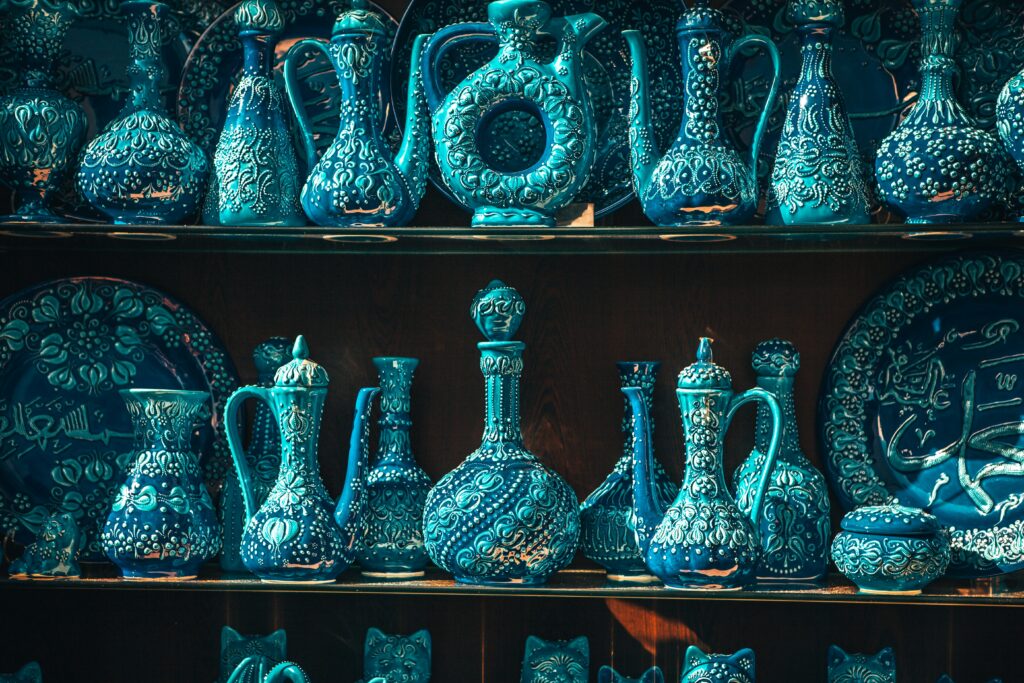
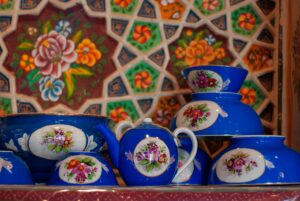
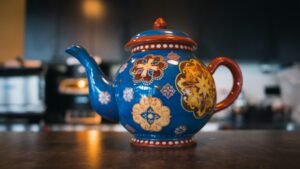
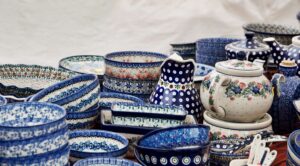
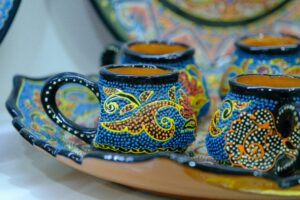
One thought on “Multani Blue Pottery: 5 Must-Know Facts Behind Its Stunning International Comeback”